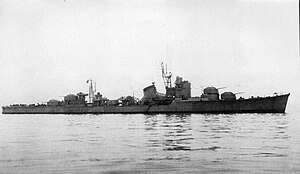 Harutsuki in December 1944
| |
| History | |
|---|---|
| Name | Harutsuki |
| Builder | Sasebo Naval Arsenal |
| Laid down | 23 December 1943 |
| Launched | 3 August 1944 |
| Completed | 28 December 1944 |
| Commissioned | 28 December 1944, 11th Destroyer Squadron |
| Stricken | 5 October 1945 |
| Fate | Transferred to the Soviet Union, 28 August 1947 |
| Name | Vnezapny (Внезапный) |
| Acquired | 28 August 1947 |
| Commissioned | 25 September 1947, 5th Fleet |
| Renamed |
|
| Stricken | 4 June 1969 |
| Fate | Scrapped |
| General characteristics | |
| Class and type | Akizuki-class destroyer |
| Displacement |
|
| Length | 134.2 m (440 ft 3 in) |
| Beam | 11.6 m (38 ft 1 in) |
| Draft | 4.15 m (13 ft 7 in) |
| Propulsion |
|
| Speed | 33 knots (38 mph; 61 km/h) |
| Range | 8,300 nmi (15,400 km) at 18 kn (21 mph; 33 km/h) |
| Complement | 263 |
| Armament |
|
Harutsuki (春月, "Spring Moon") was an Akizuki-class destroyer of the Imperial Japanese Navy. Her name means "Spring Moon". She was different from her other sisters, as she was built as a flagship for the Escort Fleet.
Design and description
The Akizuki-class ships were originally designed as anti-aircraft escorts for carrier battle groups, but were modified with torpedo tubes and depth charges to meet the need for more general-purpose destroyers. The ships measured 134.2 meters (440 ft 3 in) overall, with beams of 11.6 meters (38 ft 1 in) and drafts of 4.15 meters (13 ft 7 in). [1] They displaced 2,701 long tons (2,744 t) at standard load [2] and 3,420 long tons (3,470 t) at deep load. [3] Their crews numbered 300 officers and enlisted men. [2]
Each ship had two Kampon geared steam turbines, each driving one propeller shaft using steam provided by three Kampon water-tube boilers. The turbines were rated at a total of 52,000 shaft horsepower (38,776 kW) for a designed speed of 33 knots (61 km/h; 38 mph). The ships carried enough fuel oil to give them ranges of 8,300 nautical miles (15,400 km; 9,600 mi) at speeds of 18 knots (33 km/h; 21 mph). [4]
The main armament of the Akizuki class consisted of eight 100-millimeter (3.9 in) Type 98 dual-purpose guns in four twin- gun turrets, two superfiring pairs fore and aft of the superstructure. They each carried a dozen 25-millimeter (1 in) Type 96 anti-aircraft (AA) guns in four triple-gun mounts. The ships were also each armed with four 610-millimeter (24 in) torpedo tubes in a single quadruple rotating mount amidships; one reload was carried for each tube. [5] The later batches of ships were each equipped with six depth charge throwers for which 72 depth charges were carried. Harutsuki was equipped with a Type 21 early-warning radar on her foremast. [6]
Construction and career
On 5 October 1945, Harutsuki was removed from Navy List. On 28 August 1947, she was turned over to the Soviet Union, renamed Vnezapny (Внезапный) and rearmed with eight 102-millimeter (4 in) guns, fifteen 25 mm guns and four 533-millimeter (21 in) torpedo tubes. She became the training ship Oskol in 1949, target ship TsL-64 in 1955 and finally floating barracks PKZ-37, scrapped in 1969.
Notes
References
- Dodson, Aidan & Cant, Serena (2020). Spoils of War: The Fate of Enemy Fleets after Two World Wars. Barnsley, UK: Seaforth Publishing. ISBN 978-1-5267-4198-1.
- Jentschura, Hansgeorg; Jung, Dieter & Mickel, Peter (1977). Warships of the Imperial Japanese Navy, 1869–1945. Annapolis, Maryland: United States Naval Institute. ISBN 0-87021-893-X.
- Rohwer, Jürgen (2005). Chronology of the War at Sea 1939–1945: The Naval History of World War Two (Third Revised ed.). Annapolis, Maryland: Naval Institute Press. ISBN 1-59114-119-2.
- Stille, Mark (2013). Imperial Japanese Navy Destroyers 1919–45 (2): Asahio to Tachibana Classes. Botley, UK: Osprey Publishing. ISBN 978-1-84908-987-6.
- Sturton, Ian (1980). "Japan". In Chesneau, Roger (ed.). Conway's All the World's Fighting Ships 1922–1946. Greenwich, UK: Conway Maritime Press. ISBN 0-85177-146-7.
- Todaka, Kazushige, ed. (2020). Destroyers: Selected Photos from the Archives of the Kure Maritime Museum; the Best from the Collection of Shizuo Fukui's Photos of Japanese Warships. Japanese Naval Warship Photo Album. Annapolis, Maryland: Naval Institute Press. ISBN 978-1-59114-630-8.
- Whitley, M. J. (2000). Destroyers of World War Two: An International Encyclopedia. London: Cassell & Co. ISBN 1-85409-521-8.